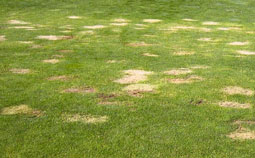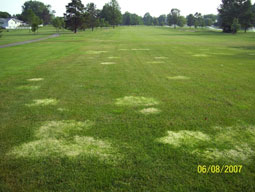White-Out Weedy Bents
Controlling creeping bentgrass contamination in cool-season roughs, and occasionally fairways, has long been a source of frustration for superintendents and golfers alike. Whereas advances in creeping bentgrass breeding have provided some of the finest playing surfaces in the world on greens, tees and fairways, creeping bentgrass does not perform well at mowing heights above 5 / 8 of an inch, because it is very difficult to manage and becomes extremely puffy resulting in an uneven turfgrass canopy that ultimately offers poor playability.
 |
|
 |
|
| Mesotrione's bleach-like effect on invasive creeping bentgrass in a cool-season fairway (top) and rough (bottom). Photos courtesy of Matt Giese, Syngenta. |
Through conversations with university and industry representatives, it has been learned that applications of mesotrione are best scheduled during late summer and early fall. In so doing, the surrounding grasses or seedlings can fill in the open voids during optimum growing conditions. Looking forward, developing a management strategy using mesotrione could prove valuable in controlling bentgrass invasion of fairways and roughs, and significantly reduce the need to frequently resod cool-season green, tee and bunker surrounds.
For more information on bleaching out any weedy bentgrasses, visit www.tenacityherbicide.com or contact your regional Syngenta representative.
We urge you to visit our Web site at www.usga.org/turf to learn more about Green Section programs and to stay up-to-date on activities in the Mid-Continent area. The ur Mid-continent Regional Web site updates will be posted every two weeks. Thank you for your support of the Turfgrass Advisory Service. Please do not hesitate to contact either of the Mid-Continent regional offices: Ty McClellan/Julie Vermeulen at tmcclellan@usga.org or (630) 340-5853 or Bud & Karen White at budwhite@usga.org or (972) 662-1138 should you have any questions or if we can help you in any other way.
![]()
